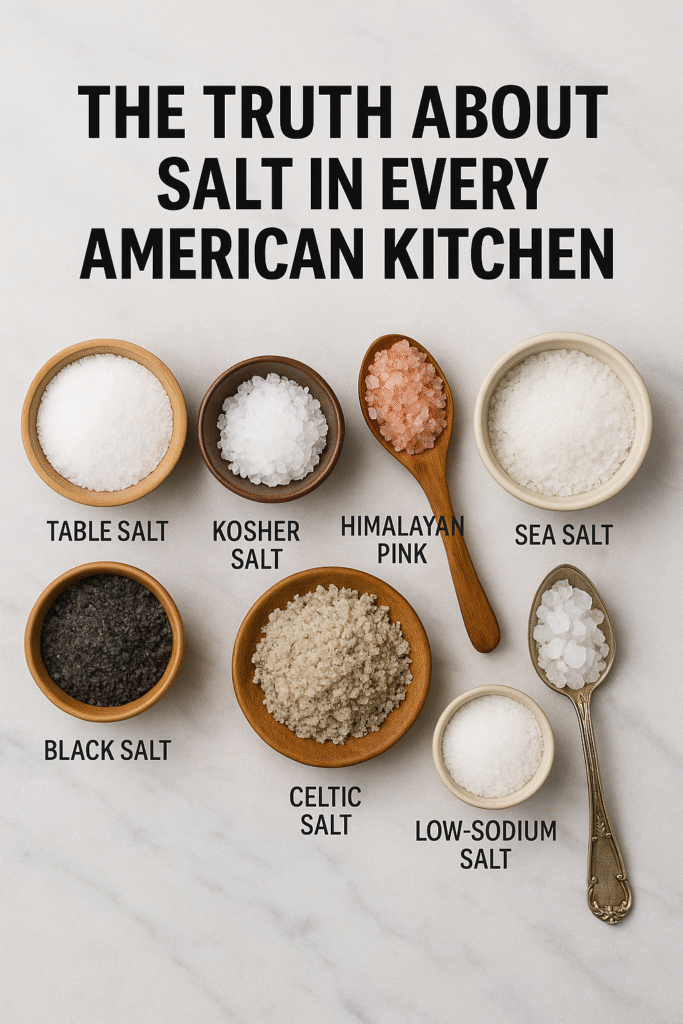Have you ever paused to think about the salt you use every day? That simple white sprinkle in your cooking not only adds flavour but also plays a vital role in your health, digestion, and even hormonal balance. let’s understand about Truth About Salt in Every American Kitchen
In the United States, salt is more than just a seasoning — it’s a conscious choice. From traditional table salt to Himalayan pink crystals, each type of salt carries its own benefits, brands, and uses. Let’s take a closer look at the most popular salts used in American homes and discover which one fits your lifestyle best.
1. Table Salt: The Everyday Habit
Table Salt is the backbone of most American kitchens. It’s fine-grained, bright white, and usually enriched with iodine — an essential mineral for thyroid health. Used in everything from boiled eggs to pasta, this salt blends easily into any dish. The most recognized brand in the U.S. is Morton, famous for its iconic packaging featuring a little girl holding an umbrella. Extracted from underground salt mines and heavily refined, it remains the most budget-friendly and commonly available salt on supermarket shelves.
Iodized – supports thyroid health
Ideal for everyday cooking – pasta, eggs, soup, veggies
Easily available in Walmart, Target, and Costco
✅ Benefits:
Affordable and accessible
Helps prevent iodine deficiency
❌ Drawbacks:
Highly refined – lacks natural minerals
Overuse may lead to high blood pressure
2. Kosher Salt: The Chef’s Choice
Kosher salt has earned its place in professional and home kitchens alike. With its large, flaky crystals, it’s easy to pinch and sprinkle — offering more control when seasoning meats or vegetables. Originally used for koshering meat in Jewish tradition, today it’s praised for its clean flavor and versatility. Whether you’re dry-brining a steak or seasoning popcorn, Kosher salt delivers without overpowering. Its low density means you can use more without oversalting your food.
Non-iodized – pure and mild taste
Brands: Diamond Crystal, Morton
Sold in boxes of 3–5 lbs
✅ Benefits:
Allows better seasoning control
Preferred in grilling, roasting, and dry rubs
Less likely to over-salt dishes
❌ Drawbacks:
Lacks iodine
Requires recipe adjustments due to crystal size
3. Himalayan Pink Salt: Health in Style
This stunning rose-colored salt has become a staple in health-focused kitchens across the USA. Mined from the ancient Khewra Salt Mine in Pakistan, Himalayan Pink Salt contains over 80 trace minerals, giving it its unique color and subtle earthy taste. Not only does it add flavor, but it’s also used in detox water, salt lamps, and even skincare routines. Whether ground finely or served in large chunks, it’s more than salt — it’s a lifestyle symbol.
Packed with trace minerals
Natural pink color
Popular brands: SaltWorks, Himalayan Chef, The Spice Lab
✅ Benefits:
Helps restore mineral balance in the body
Enhances taste with a mild, sweet flavor
Widely used in wellness and detox diets
❌ Drawbacks:
Significantly more expensive
Not all health claims are scientifically proven
4. Sea Salt: Ocean’s Mineral Touch
Sea Salt is produced by evaporating ocean water and contains natural minerals like magnesium, calcium, and potassium. Its coarse, irregular crystals add texture and depth to food, especially when used as a finishing touch. This salt is less processed than table salt, giving it a more natural profile. It’s a favorite among bakers, food stylists, and chefs who want a crunchier, gourmet finish on dishes like steaks, cookies, and salads.
Sourced from Atlantic and Pacific Oceans
Sold in grinders, jars, and resealable packs
Brands: Morton Sea Salt, La Baleine
✅ Benefits:
Mild natural minerals remain intact
Offers crunch and visual appeal
Great for finishing gourmet meals
❌ Drawbacks:
Does not contain iodine
Pricier than refined table salt
5. Celtic Salt: Grey Salt for Natural Living
Celtic Salt is a moist, greyish sea salt harvested from the coast of Brittany, France. It retains its moisture and many natural minerals, making it popular in holistic and natural diets. This salt is sun-dried and hand-raked using traditional methods, giving it an artisanal touch. Its slightly briny taste works well with soups, stews, and salads, while its mineral-rich profile supports hydration and muscle function.
Light grey, damp texture
Unrefined and traditionally harvested
Brand: Selina Naturally
✅ Benefits:
Rich in magnesium, potassium, and trace elements
Minimally processed
Helps maintain electrolyte balance
❌ Drawbacks:
Moisture may cause clumping
Higher price and limited shelf availability
6. Black Salt: India’s Sulfurous Secret
Black Salt (Kala Namak) has made its way into the American market via Indian cuisine and Ayurvedic wellness trends. With its pungent, sulfur-like aroma and dark pinkish-grey hue, it’s a favorite for enhancing fruit dishes, chutneys, and vegan scrambles. Though it’s acquired taste, it’s revered for its digestive benefits and is a staple in many detox recipes.
Sourced from India and Nepal
Brands: Rani, Deep, Spicy World
Found in Indian grocery stores & Amazon
✅ Benefits:
Aids digestion and reduces gas
Supports Ayurvedic detox routines
Used in fruit salads, lemonades, and chaat
❌ Drawbacks:
Strong smell may not appeal to everyone
Not suitable for large daily use
7. Low-Sodium Salt: For the Heart Health Watchers
Designed for people with high blood pressure or sodium sensitivity, Low-Sodium Salt contains potassium chloride instead of traditional sodium. It’s a smart substitute for daily use if you’re on a heart-friendly diet. However, it’s not recommended for individuals with kidney problems due to its potassium content.
Blended or potassium-based
Brands: Morton Lite Salt, LoSalt
Available in pharmacies and groceries
✅ Benefits:
Helps reduce sodium intake
Suitable for heart and blood pressure management
❌ Drawbacks:
Taste slightly differs from regular salt
Not suitable for people with kidney disorders
8. Rock Salt: The Ice Cream Maker’s Secret
Rock Salt isn’t meant for cooking but plays a big role behind the scenes — especially in homemade ice cream machines. These large crystals help lower the freezing point of ice, allowing smooth churning and better consistency during ice cream making.
Sold as Morton Ice Cream Salt
Non-edible, technical use only
Available at Walmart, Amazon
✅ Benefits:
Helps freeze ice cream evenly
Essential for certain freezing methods
❌ Drawbacks:
Not safe for consumption
Must be stored separately
Which Salt Is Most Commonly Used in the USA?
When it comes to daily use, Table Salt clearly dominates American kitchens. It’s cheap, easy to find, and comes fortified with iodine — making it a safe everyday option. Whether in home cooking, processed foods, or restaurant meals, it remains the default choice.
Kosher Salt comes in second place, especially among chefs and food enthusiasts looking for more texture and control.
Which Salt Is Right For You?
| Your Need | Best Salt Option |
|---|---|
| Daily cooking + iodine | Table Salt |
| Grilling, roasting, control | Kosher or Sea Salt |
| Holistic & wellness lifestyle | Himalayan or Celtic Salt |
| Digestion & detox | Black Salt |
| Low-sodium or heart care | Low-Sodium Salt |
| Ice cream / freezing only | Rock Salt (non-edible) |
Choose wisely — salt isn’t just seasoning, it’s a decision that touches your health every day.
>Your salt. Your style. Your body’s balance.







